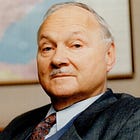In May 1972, at the height of the Cold War, the United States and the Soviet Union signed a seemingly incongruous pact: a bilateral agreement to cooperate on environmental protection. Amid a world divided by ideology, top officials in Washington and Moscow found common cause in fighting pollution and ecological damage. This quiet convergence, largely overlooked by the public at the time, was no anomaly. It was a sign of things to come. Environmentalism, far from being a purely grassroots uprising of concerned citizens, was evolving into a strategic vehicle for bridging East and West – and a handy justification for supranational governance that neither side could achieve alone.
This is a summary of the recent Substack posts linked below.
In popular memory, the birth of the modern environmental movement is often painted as an organic reaction to visible crises: smog-choked cities, rivers catching fire, oil spills on pristine shores. Ordinary people were indeed alarmed and demanded change. But high above this genuine concern, a strategic agenda was taking shape. Power brokers in both capitalist and communist spheres recognised that global environmental issues could transcend borders and politics. If the planet itself was in peril, wouldn’t nations have to set aside differences and follow a common plan? This alluring logic was not lost on Cold War strategists. By casting pollution and resource scarcity as universal threats, they could justify new forms of collaboration – and control – that would have been politically unthinkable otherwise.
Systems theory became the magic word. This was an approach that viewed the world as one big, interlinked system – something that could be studied, modeled, and managed with the right expertise. For technocrats in the West and planners in the East, systems theory held tremendous appeal. It promised a scientific way to solve social problems, whether economic stagnation or environmental decline. In the early 1970s, this thinking crystallised in institutions explicitly designed to merge Eastern and Western efforts. One landmark example was the creation of the International Institute for Applied Systems Analysis (IIASA) in 1972, a research center jointly sponsored by the U.S., USSR, and other countries to tackle global problems through computer modeling and systems analysis. At IIASA, Soviet scientists and Western experts sat together refining computer simulations of climate trends, resource depletion, and population growth. Ideology took a back seat to data, or so it seemed. By feeding in numbers and churning out scenarios, they could claim to predict humanity’s future – and prescribe what had to be done globally to avoid catastrophe.
These models all tended to show one thing: disaster loomed unless someone planned far ahead and at a planetary scale. In 1972, a famous report by the Club of Rome warned of the Limits to Growth on a finite planet, painting a dire picture of collapse if consumption and population were not controlled. Suddenly, supranational planning sounded not only reasonable but urgent. If pollution ignored political borders, then so must the solutions. And if a computer printout said the earth was running out of resources, who were mere voters or local politicians to disagree? Systems modeling provided a seemingly neutral, scientific justification for setting up decision-making towers above the nation-state. It’s no coincidence that by the end of that decade, global conferences and UN agencies were busily drafting protocols and strategies for coordinated environmental regulation. The message was consistent: only global governance could save the planet.
While this intellectual and institutional synthesis was underway, the face of environmental activism was also being carefully managed. In the Soviet Union, where genuine bottom-up protest was virtually impossible, the regime allowed a controlled version of ecological advocacy to exist. There was an official All-Russian Society for Nature Protection – known by its Russian acronym VOOP – that had been around in some form since the 1920s. On paper, VOOP looked like a civic organisation devoted to conservation. It organised tree-plantings, published pamphlets about endangered species, and even permitted mild criticism of local pollution problems. But VOOP was a classic example of controlled opposition. Its leadership was stacked with Communist Party-approved loyalists almost as soon as Khruschev rose to power. Its activities stayed within lines drawn by the state. If a factory was poisoning a river, VOOP might raise an alarm – but cautiously, and never in a way that truly threatened the authority of the planners in Moscow. By allowing a semblance of public dissent on environmental matters, Soviet authorities deflected pressure and even earned praise from foreigners for having ‘green’ initiatives. In truth, it was window dressing. The big industrial schemes – draining fertile wetlands, diverting rivers, building nuclear reactors with scant safety – went ahead regardless of the small protests. The illusion of an independent environmental movement was maintained to keep citizens hopeful that problems were being addressed, and to signal to the world that the USSR was as environmentally conscious as the West pretended to be.
Meanwhile, in the West, environmental organisations were more authentic in origin but soon found themselves courted and co-opted by powerful interests. By the 1980s, many prominent NGOs relied on grants from large foundations and even governments that quietly steered their agendas. Elite figures like Maurice Strong understood this dynamic well. Strong – a Canadian businessman with deep ties to the UN – had been instrumental in choreographing the Stockholm Conference in 1972, the first great global environmental summit, and he later became the founding head of the UN Environment Programme. From those perches, Maurice Strong championed the rise of NGOs and ‘civil society’ groups in global decision-making. He knew that these groups carried an aura of moral authority and grassroots legitimacy. By the late 1970s, one initiative backed by Strong – the International Foundation for Development Alternatives – even explicitly promoted a concept called the Third System. The idea was that neither governments (the first system) nor private corporations (the second system) should dominate the future, but rather a third sector of non-governmental, people-centered organisations would guide the world. It sounded empowering – giving voice to citizens’ groups everywhere – but in practice this Third System was financed and guided by the same old powers. Environmental NGOs became the foot soldiers of a new global order, one where public policy could be swayed not just in parliament or politburo, but via international campaigns and expert-studded conferences. Civil society was the smiley face of supranational planning.
The convergence of East and West through environmentalism wasn’t just theoretical – it played out through key personalities who moved seamlessly from one domain to another. Consider Yuri Izrael, a top Soviet scientist who for years headed the USSR’s official Hydrometeorology and Environmental Monitoring Service. Izrael was no crusading eco-warrior; in fact, he was responsible for managing – and often downplaying – some of the worst environmental disasters of the Soviet era. When the Chernobyl nuclear reactor exploded in 1986, it was Izrael’s agency that tracked the radiation. Instead of warning the public immediately, Soviet authorities, Izrael included, initially shrouded the event in secrecy. Desperate to prevent mass panic (and protect the state’s image), they even resorted to seeding clouds to force radioactive rain to fall on rural areas, sparing big cities like Moscow from fallout. After such a track record, one might expect Izrael to fade into obscurity with the Soviet collapse. Yet he found a second life on the world stage: in the 1990s he became a leading figure in the Intergovernmental Panel on Climate Change (IPCC) – the very body tasked with informing humanity about environmental risks and guiding global climate policy. Izrael rose to be a vice-chair of the IPCC, portraying himself as a sober-minded climate expert. The irony is stark: a man who once helped conceal an ecological calamity was now helping to direct international alarm over ecological crises. But in a way, it makes perfect sense. The new system didn’t require believers in environmental idealism; it needed managers and loyalists. Izrael’s presence in the IPCC showed how old guard operatives could be repurposed for the new global agenda.
Another Soviet-era figure, Viktor Kovda, illustrates a similar pattern. Kovda was a respected soil scientist who navigated the upper echelons of Soviet academia and bureaucracy for decades. In the 1960s he had a foot firmly in the international camp – even serving as a department director at UNESCO, where he helped shape early global environmental and development programs. At home, Kovda had witnessed the horror of ill-conceived schemes like Stalin’s Great Plan for the Transformation of Nature and later the massive irrigation projects that drained Central Asian lakes and turned fertile soil to salt. He often raised cautious criticisms of these policies – but always within limits, careful not to offend the Kremlin. In an nation state contemporarily characterised by political purges, Kovda became an influential voice advising not only the Soviet state on agriculture and ecology, but he further became an influential international advisor on environmental matters. Come the era of global conferences, he stepped onto the world stage, participating in forums on issues like desertification and biosphere reserves. In effect, Kovda and scientists like him were the carriers of Soviet environmental science into global institutions. They brought along the Soviet preference for large-scale, centralised solutions, couched in the new language of sustainability. And the world welcomed them as esteemed experts. It’s telling that in 1992, when the United Nations rolled out its grand plan for sustainable development (Agenda 21), veterans like Kovda were there to provide intellectual heft – lending the credibility of science to what was, at its core, a political blueprint.
On the Western side, Maurice Strong remained a pivotal architect of this blueprint. If Soviet scientists offered technical know-how and a penchant for central planning, Strong provided the globalist vision and political connections. He organised the 1992 Earth Summit in Rio de Janeiro with almost missionary zeal, bringing together world leaders, diplomats, NGOs, and businessmen under the banner of saving the Earth. The outcome of the Earth Summit was marketed as a voluntary action plan for sustainable development. It touched everything — even how cities should be designed, how children should be educated about the environment, and how international finance should be oriented. Though not a legally binding treaty, Agenda 21 became enormously influential – a guiding template for countless laws and regulations around the world in the following decades. Strong, of course, was at the center of it, cheerleading the notion that ‘global problems need global solutions’. To skeptics, he reassured that it was all about the grassroots – ‘think globally, act locally’, as the slogan went. But the reality was that an extensive bureaucratic apparatus was being set up, one that connected local municipalities and NGOs directly with international bodies, often bypassing national governments when convenient. The environmental narrative provided moral cover for this shift. After all, who could oppose clean air, clean water, and a stable climate? Under that feel-good umbrella, a remarkable political rearrangement was happening: decision-making was oozing upward and outward, into the hands of unelected global committees and their partnered NGOs.
To understand the ideology behind this, we need to step back and see the larger picture. The Cold War was a clash of two systems – capitalism versus communism – but there had long been a hope among certain thinkers that a synthesis was possible. As early as the 1920s, the revisionist socialist Eduard Bernstein had spoken of evolving beyond the extremes of free-market capitalism and authoritarian socialism. His ideas foreshadowed what later came to be known as a Third Way or here, the Third System. This was not a mere compromise on economic policy; it was envisioned as a fundamental reordering of how society was governed, and by the 1970s, influential circles in the West were actively exploring this. The formation of the Trilateral Commission in 1973 is a case in point. It brought together elites from North America, Western Europe, and Japan to strategise for a future beyond Cold War divisions. These were bankers, political leaders, corporate executives, and intellectuals – people like David Rockefeller, Zbigniew Brzezinski, and other luminaries of the era. Officially, they were addressing the challenges of interdependence – the idea that the world’s economies and problems were becoming so intertwined that no nation could solve things alone. Unofficially, the Trilateral Commission embodied an emerging consensus that global management by a tightly-knit group was necessary to guide the world through turmoil (energy crises, economic stagflation, resource limits, etc.) — real, or not. Importantly, early on they recognised the utility of the environmental cause. If the public could see humanity’s survival as a collective task, they would be more willing to accept collective solutions and oversight that bypassed traditional politics. Environmentalism, with its broad appeal and inherent urgency, was the perfect Trojan horse for introducing a new mode of governance.
By the end of the 20th century, much of this vision was being realised. With the Soviet Union gone, many assumed the world would simply march to the drum of free markets and liberal democracy. And outwardly it did – for a while. But beneath the surface, the convergence never really stopped. The European Union expanded a style of bureaucratic regional governance that often resembled top-down planning more than democratic deliberation. Russia and China, officially converted to capitalism, nonetheless maintained tight state control and became enthusiastic participants in global deals on climate and development (seeing in them a way to constrain rivals and benefit from new finance flows). In the West, governments increasingly partnered with big corporations and NGOs to push environmental regulations that were international in scope. Initiatives like the Kyoto Protocol and later the Paris Agreement bound nations into common frameworks, policed not by voters, but by panels of experts and negotiators. We entered an age of global governance – not one world government, but an array of treaties, agencies, and networks that collectively wield great influence over national policies. All of it was sold as necessary for the common good.
Now, in the 21st century, this apparatus is reaching deeper than ever into our daily lives. The marriage of environmental rhetoric with high tech control has given rise to tools and policies that would make earlier generations’ jaws drop. Central Bank Digital Currencies (CBDCs), for instance, are being promoted as a way to create efficient, cashless societies – and quietly marketed as supportive of green goals (digital transactions leave clear trails for tracking carbon footprints and ensuring ‘sustainable consumption’). In parallel, we see the emergence of social credit systems – most visibly in China, where citizens are scored on their behavior, but increasingly in Western proposals tying access to services or travel with one’s compliance to health or environmental rules. Imagine a future where your personal ‘eco-score’ or carbon usage could affect your financial access; this is no longer sci-fi speculation but a logical extension of current pilot programs. Then there’s the Convention on Biological Diversity’s Ecosystem Approach, a term cropping up in global environmental circles. On the surface it means considering the entire ecosystem in decision-making – a holistic view that sounds wise. In practice, it typically means empowering centralised authorities to override local decisions. If a village’s way of life is deemed incompatible with preserving a regional ecosystem, the people in charge of top-down integrated land management — the ecosystem approach — feel justified in dictating changes. After all, they argue, the needs of the planet trump the preferences of a community. We’ve seen this play out in proposals to resettle populations away from certain ‘protected’ areas, or to approve development projects even if the local populace rejects these, because some black box global model incredibly has been tuned to predict a positive impact ‘for the common good’.
All these mechanisms – digital currencies, behavior scores, ecosystem planning – are being rolled out under the banner of solving a crisis. Whether that crisis is climate change, biodiversity loss, or some other looming catastrophe, the solution offered is remarkably consistent: trust the global experts, centralise decisions, enforce compliance, and in return we’ll save you. It is a profound inversion of the classic social contract. Instead of leaders accountable to the people, we get leaders claiming to be accountable to the planet. Instead of measuring success by individual freedom or happiness, we are told to measure it by carbon parts per million or other abstract indicators. Dissenting voices are dismissed as ‘deniers’ or selfish reactionaries who just don’t grasp the urgency. The moral high ground is constantly claimed by those driving this agenda – they are the compassionate ones, the forward-thinkers, the guardians of our children’s future. By implication, anyone objecting to how they want to reorder the world is painted as short-sighted or downright immoral.
It is here that environmentalism as a narrative reveals its ultimate utility: it wraps global control in a cloak of benevolence. Who could object to cleaner air and water? Who doesn’t want to avert a climate disaster? We find ourselves disarmed by the very language of this crusade – words like ‘sustainability’, ‘resilience’, and ‘equity’, which no decent person would normally oppose. But look closer at how these lovely ideals are being implemented, and it becomes clear that we’re not just planting trees and recycling bottles. We’re restructuring society. Decisions that used to be local or personal are increasingly made by faceless committees and algorithms. Policies that once required open debate are now rushed through as emergency measures for the planet’s sake. The scope of central authority is expanding, reaching into how we use energy in our homes, what kind of car we can drive (or even if we can drive at all), what we eat, how we spend our money, and even what opinions we’re allowed to express, with content that questions drastic policies being flagged as ‘misinformation’ or ‘ecocide crimes against the environment’, leading to algorithmic censorship on social media. It is a comprehensive apparatus of global moral governance – and it presents itself as our savior. But it doesn’t typically inform you what’s on the other side of that coin.
It’s time to reevaluate not just the fine print of the latest climate bill or sustainability initiative, but the entire narrative we’ve been fed. Yes, we all care about the environment and want a livable planet for future generations. But we must distinguish genuine stewardship from stewardship as a power play. The history traced here – from East-West backroom deals in the 1970s, through the rise of systems theory and international NGOs, to the polished global roadmaps like Agenda 21 – shows that environmentalism has long been used as a means to an end. That end is a form of governance that operates above and beyond democracy, often cloaked in noble intentions, discussed by members behind closed doors at the Trilateral Commission, and monetised by the members of the World Economic Forum. We, the regular people, are told it’s all for our own good, for the common good. Yet we were never honestly asked how we want our good to be defined, or who gets to define it.
It’s not too late to challenge this trajectory. Awareness is the first step. Once we see that what’s presented as an inevitable, ‘scientific consensus’ is actually a project shaped by very human interests and ideologies, we can start to ask the right questions. Who benefits from these sweeping global programs? Who loses? Why are alternative viewpoints so fervently shut down? Perhaps most importantly — what kind of world do we want, and do we get a say in it? The convergence of East and West in the realm of environmental governance was not about East or West winning – it was about a new system emerging, one that takes the command-and-control instincts of one side and the public relations savvy of the other to create something more subtle and pervasive than either.
The future being crafted under the banner of green virtue is one of meticulous management of every aspect of life – what one might call a ‘technocratic eco-tyranny’ if it weren’t so politely dressed up. Environmentalism, in essence, has become a mask for centralisation, we need one that is a motor for genuine empowerment. That means peeling back the layers of propaganda and recognising when ‘common good’ is used as a catch-all excuse to sidestep common people.
The environment is a legit concern – but it must not become a blank check for a global managerial class. The next time we are told that ‘we’re all in this together’ and thus must accept some sweeping plan for our own sake, let’s pause and examine whose hand is on the pen writing that plan. We might find, as we did in this historical journey, that the script was written long ago, by a coalition of East-West pragmatists who saw in crisis the perfect opportunity for control.
And understanding that playbook is the first step in reclaiming our future from it.









